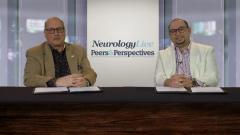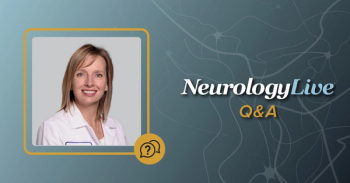
Sequencing of Therapies in MS
Experts in neurology highlight the factors they consider when switching treatments for a patient with MS.
Episodes in this series

Ahmed Zayed Obeidat, MD, PhD: One of the other questions, since we’re talking about cladribine, we talked about the short-term immune suppression followed by immune re-population, or reconstitution in a way. It takes some time to come back to near normal limits of lymphocyte counts. Then when you switch, let’s say you’re switching from oral cladribine to a different agent, that would be if oral cladribine didn’t do the job for the patient. Maybe they have breakthrough disease activity. Or the opposite situation, which is probably more common, where you’re going to be switching from something to oral cladribine. How do you do this in clinical practice? You mentioned something about rebound.
Mark S. Freedman, HBSc, MSc, MD, CSPQ, FAAN, FRCPC: Sequencing.
Ahmed Zayed Obeidat, MD, PhD: Sequencing is really important. We have labels that say what to do, but then the real world is different.
Mark S. Freedman, HBSc, MSc, MD, CSPQ, FAAN, FRCPC: They don’t tell you what to do.
Ahmed Zayed Obeidat, MD, PhD: You cannot just do that. That’s where the shared decision-making and informed consent comes into play in talking to patients about what would be the best way for their own case. That’s one of the things to talk about.
Mark S. Freedman, HBSc, MSc, MD, CSPQ, FAAN, FRCPC: Whatever you’re choosing to begin with, you should also have in your mind a plan B. We do this in other areas of neurology. If you’re treating migraine, and you picked one drug and it didn’t work, you know what you’re going to use next.
Ahmed Zayed Obeidat, MD, PhD: The next step.
Mark S. Freedman, HBSc, MSc, MD, CSPQ, FAAN, FRCPC: In epilepsy, you know what you’re going to use. You have your favorites. So in MS [multiple sclerosis], if you’ve chosen a therapy, and maybe it wasn’t enough to control the disease, and we can touch on how we determine that in a moment. But let’s say there’s a certain amount of breakthrough that is unacceptable, then I know I’m going to go to plan B. Now plan B may not be so easy.
If you’re coming from one oral therapy to another, let’s say we’re on an S1P [sphingosine-1-phosphate], and then you’re going to use a drug like oral cladribine. There’s a unique problem here because you’ve got an S1P receptor agonist that’s sequestering lymphocytes in the lymph nodes. You want to expose the body to cladribine, which is essentially like a chemotherapy drug, but you’re pulsing it. They only take it for 1 week in month 1, 1 week in month 2. You want to know that they can get to the lymphocytes that are their target. If they’re sitting in the lymph nodes, it’s possible that the cladribine will have good penetration in the lymph nodes, but it would be much better if those cells were circulating. You have to think about how fast those cells are going to come out of the lymph nodes. If you wait too long, you’ll get a rebound.
Ahmed Zayed Obeidat, MD, PhD: Rebound, and you don’t want that.
Mark S. Freedman, HBSc, MSc, MD, CSPQ, FAAN, FRCPC: You want to get in there early, early enough that as the cells repopulate, you’re going to be able to hit them. Usually at about month 1 to 2, when the lymphocyte count starts to edge its way up, that’s when we will implement that.
Ahmed Zayed Obeidat, MD, PhD: When you would use that.
Mark S. Freedman, HBSc, MSc, MD, CSPQ, FAAN, FRCPC: Cladribine has a safety valve in it, in that you cannot give it unless the lymphocyte count is near normal. If it’s grade 1, maybe, but you’d want a normal lymphocyte count to start with. So it’s dicey because you have to wait for the cells to come back. You’re always sort of balancing the rebound risk against the notion that you’re going to get in. There’s another problem in that they can have PML [progressive multifocal leukoencephalopathy]. We know that. If you have even a little bit of PML, and you give someone a cell depletion therapy….
Ahmed Zayed Obeidat, MD, PhD: That PML is going to expand.
Mark S. Freedman, HBSc, MSc, MD, CSPQ, FAAN, FRCPC: The PML will kill you. Because now, the only good remedy for PML is your own immune system.
Ahmed Zayed Obeidat, MD, PhD: Yes, exactly, the immune system.
Mark S. Freedman, HBSc, MSc, MD, CSPQ, FAAN, FRCPC: If your immune system is compromised, you’re in trouble. When we go from an S1P, and I don’t care who they are, this is what we do in our clinic, and we do the same even with dimethyl fumarate.
Ahmed Zayed Obeidat, MD, PhD: You still do an exit MRI….
Mark S. Freedman, HBSc, MSc, MD, CSPQ, FAAN, FRCPC: Even though the risk is lower, I feel more comfortable having the exit MRI and a spinal tap. We’ll do a CSF [cerebrospinal fluid] for JC [John Cunningham] virus by PCR [polymerase chain reaction test].
Ahmed Zayed Obeidat, MD, PhD: Oh, wow.
Mark S. Freedman, HBSc, MSc, MD, CSPQ, FAAN, FRCPC: It takes 2 weeks to get the results, but now I know that if I hit them with a cell depletion therapy and they got PML, I did everything I could to prove that they didn’t have it before.I can stand in front of the judge, and I don’t have to be convicted of malpractice. You want to mitigate against any potential harm, and I think having a spinal tap is not a big deal.
We do that routinely on anyone who’s going from a potentially PML-causing drug, right now that’s the fumarates, the S1Ps, and natalizumab, to any cell depletion therapy. Cladribine is a cell depletion therapy, but there are all sorts of monoclonals, including alemtuzumab, which is not being used very much. All of the other cell depletion therapies could put those patients at higher risk for PML.
Ahmed Zayed Obeidat, MD, PhD: Higher risk for it, yes.
Mark S. Freedman, HBSc, MSc, MD, CSPQ, FAAN, FRCPC: You’ve got this emergence of the lymphocytes if they have been trapped in lymph nodes, you’ve got the risk of rebound, and you’ve got the mitigation against the potential for PML. Those are all things to think about when you’re sequencing. Now, we talked just a bit about how you decide when something’s not working, and this goes back to what we were talking about, realistic expectations for the patients.
Ahmed Zayed Obeidat, MD, PhD: And what tools you have in the clinic to measure that also.
Mark S. Freedman, HBSc, MSc, MD, CSPQ, FAAN, FRCPC: If you’re of the persuasion that I’m going to give this drug, and this individual will never have another attack, never have another MRI lesion, and absolutely not progress, then you’re dreaming.
Like everything in medicine, it’s about controlling the disease. If you’re treating a diabetic, and twice a week the patient reports that their sugars were high, are you ready to throw out all the pills and insulin and everything you gave them to control their diabetes? Would you say they’re not working? No, that’s unreasonable. What we’ve been trying to do over the years is come up with guidelines. In Canada we don’t call it a guideline, we call it optimizing recommendations.
Ahmed Zayed Obeidat, MD, PhD: Best practice recommendations.
Mark S. Freedman, HBSc, MSc, MD, CSPQ, FAAN, FRCPC: Right, what’s reasonable? If a patient has any attack, are you immediately going to stop it? It turns out if they have a little numbness for 2 or 3 days, didn’t need steroids, fully recovered, the MRI didn’t change, their examination is normal, why would you change? Some attacks are not so serious. On the other hand, if you have a bad motor attack, no one’s going to play games with it. It’s the kind of attacks that you’re having that matters. What if you did surveillance MRIs? If you saw a new lesion, 1, how convinced are you that it’s there?
Ahmed Zayed Obeidat, MD, PhD: Where is the location of it also, right?
Mark S. Freedman, HBSc, MSc, MD, CSPQ, FAAN, FRCPC: Maybe it was there and because of the cuts you missed it.
Ahmed Zayed Obeidat, MD, PhD: Maybe the cuts orsomething before, yes.
Mark S. Freedman, HBSc, MSc, MD, CSPQ, FAAN, FRCPC: Say you gave gadolinium, and it was 1 gadolinium-enhancing lesion; is 1 gadolinium-enhancing lesion enough to stop? I have colleagues who’ll say, “1 gadolinium-enhancing lesion, and I’m out of here.” But that’s not realistic. When you look at patients, even on therapy, who’ve developed just 1 gadolinium-enhancing lesion, they weren’t at higher risk, if you follow them in years, to have anything more. So what number of new lesions would put you at risk? There are very few studies, but at least a few of them suggested 3 or more within a year.
Ahmed Zayed Obeidat, MD, PhD: Then you would consider….
Mark S. Freedman, HBSc, MSc, MD, CSPQ, FAAN, FRCPC: In the absence of a clinical attack, and in the absence of any change in the neurological exam, that threshold may have been enough to say, I think I could do better. That’s what’s in the Canadian optimization recommendations: the kinds of attacks, whether there have been recoveries from attacks, and how many new lesions have occurred over the course of the year. If you trip over any one of those thresholds, then with all 20-odd drugs we can pick from today, it’s probably better to consider something else, and usually a higher efficacy therapy at that time.
Ahmed Zayed Obeidat, MD, PhD: Sometimes the other way happens, where you have a patient on some disease-modifying therapy, but now the reason to switch is because they are having safety issues, or adverse effects or something.
Mark S. Freedman, HBSc, MSc, MD, CSPQ, FAAN, FRCPC: There are now a couple of trials that have been released in the last year or so, like DISCO-MS. We’re getting the sense that if you’re older, have had really long-term stability, there’s been no change on your exam, however many MRIs we’ve done haven’t shown any new lesions, and the patients have reported no attacks—it turns out that if it [has been] 10 years or more, and you’re older than 60, the chances of you having another event are almost minuscule. So why not just stop the therapies? That’s kind of what we’ve been doing. In DISCO-MS, it was age 55, and I think only 5 years.
Ahmed Zayed Obeidat, MD, PhD: And in a way they didn’t take into consideration what medication they were on before, although the data are there, but we didn’t know. There was a 7% relapse [rate].
Mark S. Freedman, HBSc, MSc, MD, CSPQ, FAAN, FRCPC: It was small.
Ahmed Zayed Obeidat, MD, PhD: Small, yes.
Mark S. Freedman, HBSc, MSc, MD, CSPQ, FAAN, FRCPC: The biggest factor turns out to be your age. The younger you are, the much greater the chance you could still have activity. I kind of draw the line at 60, I’m not willing to go to 55. But if my patient’s aged 60 or more and has had that 10 years of absolute stability, we’ll have a discussion about either de-escalating for sure, but maybe stopping the therapy altogether.
Ahmed Zayed Obeidat, MD, PhD: Stopping and seeing how things go.
Mark S. Freedman, HBSc, MSc, MD, CSPQ, FAAN, FRCPC: Then they get really nervous. I [tell them] the chances that you’re going to have another event are low, and as you get older, this drug, whatever it is, might be putting you at higher risk for other problems.
Ahmed Zayed Obeidat, MD, PhD: For other problems and complications. I think about this, but sometimes we diagnose people after age 60 with their first episode. It will be like, “Uh-oh, there’s some activity.”
Mark S. Freedman, HBSc, MSc, MD, CSPQ, FAAN, FRCPC: That rule doesn’t apply to the older patient. There is even some thought that the patients with late onset MS don’t behave the same way.
Ahmed Zayed Obeidat, MD, PhD: Yes, very different.
Mark S. Freedman, HBSc, MSc, MD, CSPQ, FAAN, FRCPC: Maybe they’re more benign, I don’t know.
Ahmed Zayed Obeidat, MD, PhD: Sometimes more progression or motor symptoms.
Mark S. Freedman, HBSc, MSc, MD, CSPQ, FAAN, FRCPC: The studies are controversial on that. So, that’s a one-off, you have to decide for each patient.
Ahmed Zayed Obeidat, MD, PhD: Again, personalized therapy.
Transcript edited for clarity
Newsletter
Keep your finger on the pulse of neurology—subscribe to NeurologyLive for expert interviews, new data, and breakthrough treatment updates.



























